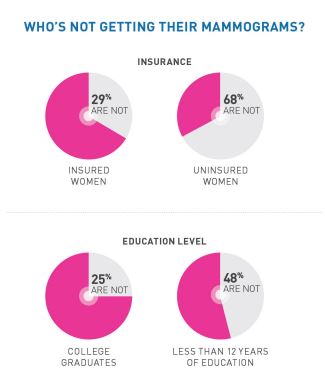Failure to diagnose breast cancer at an early stage or delay in treating breast cancer early can have deadly consequences. Early detection of the disease through regular screening such as mammogram is essential for every woman over 40 year old. According to Cancer.net, women who are diagnosed when the cancer is located only in the breast have an almost 100% chance to survive for at least 5 years. If the cancer is detected after it spread to the regional lymph nodes, the 5 year-survival rate is 85%. A woman diagnosed with breast cancer that spread to another part of her body has a 26% chance to survive more than 5 years.
Statistics also indicate that only 61% of breast cancers are diagnosed at an early stage. Unfortunately, despite campaigns such as the Breast Cancer Awareness Month that ended Yesterday, too many women over 40 years old are still not getting regular mammogram. 29% of women who have health insurance and should be screened are still not doing it. Among women who do not have health insurance, as many as 68% of them are not getting mammograms. Not having an insurance is not an excuse for not getting regular mammograms. In every city, charitable organizations offer free screenings for women who can’t afford to pay for them. In New York our firm is sponsoring free mammography vans through the Judges and Lawyers Breast Cancer Alert.
that only 61% of breast cancers are diagnosed at an early stage. Unfortunately, despite campaigns such as the Breast Cancer Awareness Month that ended Yesterday, too many women over 40 years old are still not getting regular mammogram. 29% of women who have health insurance and should be screened are still not doing it. Among women who do not have health insurance, as many as 68% of them are not getting mammograms. Not having an insurance is not an excuse for not getting regular mammograms. In every city, charitable organizations offer free screenings for women who can’t afford to pay for them. In New York our firm is sponsoring free mammography vans through the Judges and Lawyers Breast Cancer Alert.
FAILURE TO DIAGNOSE BREAST CANCER CAN BE MEDICAL MALPRACTICE
 Missed and delayed diagnoses are common medical errors that can lead to serious injury and death. This morning the Daily Mail wrote about an 11 year old boy who died from severe bowel obstruction after a doctor misdiagnosed him with constipation and sent him back home. The doctor neglected to send him for an X-ray despite symptoms consistent with bowel obstruction.
Missed and delayed diagnoses are common medical errors that can lead to serious injury and death. This morning the Daily Mail wrote about an 11 year old boy who died from severe bowel obstruction after a doctor misdiagnosed him with constipation and sent him back home. The doctor neglected to send him for an X-ray despite symptoms consistent with bowel obstruction. New York Personal Injury Attorneys Blog
New York Personal Injury Attorneys Blog





